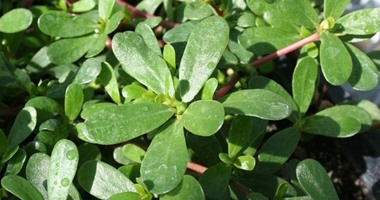Often dismissed as a common weed, purslane (Portulaca oleracea) is a nutritional powerhouse that deserves a spot in your garden and on your plate. Packed with omega-3 fatty acids, essential vitamins, and minerals, purslane offers numerous health benefits and culinary versatility. In this article, we’ll explore seven compelling reasons to cultivate purslane, along with tips on growing, harvesting, and enjoying this underrated superfood.
🌱 What Is Purslane?
Purslane is a succulent annual plant with fleshy leaves and stems, known for its slightly sour and salty taste. It’s native to many parts of the world and thrives in various environments, from gardens to sidewalk cracks. Despite its reputation as a weed, purslane is entirely edible and highly nutritious.
🧠 1. Rich in Omega-3 Fatty Acids
Purslane boasts one of the highest levels of alpha-linolenic acid (ALA), a type of omega-3 fatty acid found in plants. Remarkably, it also contains small amounts of eicosapentaenoic acid (EPA), typically found in fish and algae. These fatty acids are essential for heart and brain health, reducing inflammation, and supporting overall well-being.
🥗 2. Packed with Essential Nutrients
This leafy green is a treasure trove of vitamins and minerals:
- Vitamin A: Supports vision and immune function.
- Vitamin C: Boosts the immune system and acts as an antioxidant.
- Vitamin E: Protects cells from oxidative stress.
- Magnesium, Calcium, Potassium, and Iron: Essential for various bodily functions, including bone health and muscle function.
Calorie for calorie, purslane is one of the most nutrient-dense foods available.
❤️ 3. Supports Heart Health
The omega-3 fatty acids in purslane help lower bad cholesterol (LDL) and increase good cholesterol (HDL), reducing the risk of heart disease. Its potassium content aids in regulating blood pressure, and antioxidants prevent oxidative stress, further protecting cardiovascular health.
⚖️ 4. Aids in Weight Management and Digestion
Low in calories but high in fiber, purslane promotes satiety, helping you feel full longer and reducing unnecessary cravings. Its mucilaginous texture supports digestive health by fostering gut-friendly bacteria. Incorporate it into smoothies, stir-fries, or salads for a nutritious boost.
🛡️ 5. Natural Antioxidant Powerhouse
Purslane is rich in antioxidants like beta-carotene, glutathione, and melatonin, which combat oxidative stress and inflammation. These compounds protect against premature aging and chronic diseases. Enjoy purslane raw in salads to maximize its antioxidant benefits.
🌿 6. Easy to Grow and Drought-Resistant

Purslane thrives in poor soil and requires minimal water, making it an excellent choice for sustainable gardening. It’s drought-resistant and grows quickly, providing a continuous supply of nutritious greens. You can grow purslane from seeds or cuttings, and it flourishes in containers, raised beds, or garden borders.
🍽️ 7. Culinary Versatility
Purslane’s crunchy texture and mild, lemony flavor make it a delightful addition to various dishes:
- Raw: Add to salads, sandwiches, or wraps.
- Cooked: Use in stir-fries, soups, and omelets.
- Fermented: Create probiotic-rich side dishes.
For a simple yet nutritious side dish, sauté purslane with garlic, olive oil, and lemon juice.
🌍 Seasonal and Regional Tips
Purslane is well-suited for hot, dry climates and can be grown throughout the summer months. In regions with mild winters, it may even persist year-round. In Constantine, Algeria, for example, purslane can be cultivated during the warm season with minimal effort.
🧰 Tools and Materials Checklist
- 🌱 Purslane seeds or cuttings
- 🪴 Containers or garden beds
- 🌞 Sunny location
- 💧 Watering can or hose
- 🧤 Gardening gloves
- ✂️ Pruning shears
❌ Common Mistakes to Avoid
- Overwatering: Purslane prefers dry conditions; excessive moisture can lead to root rot.
- Poor Soil Drainage: Ensure soil is well-draining to prevent waterlogging.
- Neglecting Harvest: Regular harvesting encourages new growth and prevents the plant from becoming woody.
✅ Benefits of Growing Purslane
- Nutritional Value: High in essential nutrients and antioxidants.
- Low Maintenance: Requires minimal care and water.
- Culinary Uses: Versatile in various dishes.
- Environmental Impact: Drought-resistant and suitable for sustainable gardening.
❓ Frequently Asked Questions
Q: Is purslane safe to eat?
A: Yes, purslane is edible and highly nutritious. However, individuals prone to kidney stones should consume it in moderation due to its oxalate content.
Q: Can I grow purslane indoors?
A: Absolutely! Purslane can be grown in containers indoors, provided it receives ample sunlight.
Q: How do I harvest purslane?
A: Use scissors or pruning shears to cut the stems, leaving about two inches above the soil to encourage regrowth.
Q: Where can I find purslane seeds?
A: Purslane seeds are available at garden centers, online retailers, and sometimes in health food stores.
Q: Can I use purslane in smoothies?
A: Yes, purslane’s mild flavor makes it a great addition to green smoothies for an extra nutrient boost.
🌟 Conclusion
Purslane is more than just a weed—it’s a superfood brimming with health benefits and culinary potential. Easy to grow and maintain, this resilient plant can enhance your garden and your diet. Give purslane a try, and discover the myriad ways it can enrich your meals and well-being.
Have you tried growing or cooking with purslane? Share your experiences and favorite recipes in the comments below!
- Purslane Growing Guide – West Coast Seeds
- Anchor text: how to grow purslane successfully
- Contextual use: “If you’re new to this edible green, check out this guide on how to grow purslane successfully even in dry or sandy soils.”
- Purslane Nutrition Facts – NutritionData
- Anchor text: purslane nutrition profile
- Contextual use: “Its impressive purslane nutrition profile shows higher omega-3 content than some types of fish.”
- Using Edible Weeds in the Kitchen – Permaculture News
- Anchor text: creative ways to use edible weeds like purslane
- Contextual use: “For more creative ways to use edible weeds like purslane, explore ideas that go beyond salads.”


you are my breathing in, I own few web logs and very sporadically run out from to post : (.
961809 549986Giving you the top News is very much imptortant to us. 780358